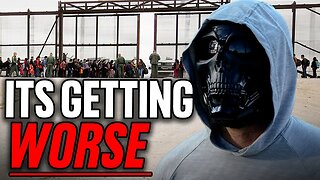Premium Only Content

Lower Inflation Being Bad For Mortgage Rates | The Curious Case
Is lower inflation bad mortgage rates? Mortgage rates are effect by Inflation and typically Inflation is bad for Mortgage rates. Lets explore what is going exactly with Mortgage rates.
Contact Me At:
602-573-3101
Email: jayson@electrumfin.com
Information provided in this video has been provided in part by https://www.mortgagenewsdaily.com/
Apply for a mortgage now at www.electrumfin.com
Download on Roku at https://my.roku.com/account/add/premtv
gettr @jaysonbates
LinkedIn @ElectrumFinancial
Jayson Bates, Owner, Electrum Financial PLLC
*Proudly Offering Purchase Mortgage Loans + Refinance Mortgage in, Arizona
More Helpful Content:
http://www.electrumfin.com
https://www.nmlsconsumeraccess.org
Applicant subject to credit and underwriting approval. Not all applicants will be approved for financing. Receipt of application does not represent an approval for financing or interest rate guarantee. Restrictions may apply, contact Jayson for current mortgage rates and for more mortgage information.
Inflation is bad for rates, but even worse is when it prompts the Fed to aggressively tighten monetary policy. In other words, the Fed is one of those forces trying to fight inflation. I argue that they are not doing a good job at it either. It does this by raising short term rates directly and also by making policy changes that indirectly push longer-term rates higher. It may seem like a cruel punishment for the Fed to push rates higher when inflation has already made things more expensive, but their rationale is that it's better than the alternative. Simply put, it’s a manipulation of the value of the dollar. The Fed does recognize that the fight against inflation will take a toll on the economy. Duh! That's the idea, after all--to slow down the "demand" side of the economy so the "supply" side eventually lowers prices. Then when balance is restored, the Fed eases policy and consumers can go back to their normal economic business without the encumbrance of decades-high inflation. The Fed's inflation fighting efforts came to a head in June. Rates shot up to their highest levels since 2008. At the time, I expected rates to remain in a sideways, volatile range based on the expectation that the Fed would want to see several months of calmer inflation data before declaring victory and even beginning to discuss easing monetary policy. But in late July, economic data was downbeat enough that markets feared an overcorrection. "Recession" was an unavoidable word in news headlines. What a difference the last two weeks have made! Troublingly weak economic data has generally been replaced with surprising strength. Last week's jobs report was a key player in that shift, even if the part time jobs or 2nd jobs is part of the report but it hasn't been the only report suggesting economic resilience. On Friday, August's preliminary reading of the Consumer Sentiment Survey beat forecasts by a wide margin--a notable shift considering the same report caused concern last month. CPI is the earlier of two key inflation reports from the US government, and it has been at the center of some of the biggest swings in rates in 2022. Last week's release showed a decisive drop for the first time all year due in large part because of lower demand on oil and the release of the strategic oil reserves. It is a drop however and the markets take it as good news. The drop was most visible in month-over-month "headline" CPI. This refers to all of the prices counted in the report whereas the "core" CPI excludes food and energy prices.
-
 58:56
58:56
The Connect: With Johnny Mitchell
18 hours ago $21.56 earnedA Migrant Smuggler Reveals How Cartel Trafficking Works, WARNS Of Conditions At The Border
60K26 -
 2:24:56
2:24:56
The Quartering
12 hours agoThe Final Boss! Expedition 33
77.7K4 -
 24:31
24:31
Liberty Hangout
5 days agoDeranged Democrats Go Insane
81.4K217 -
 11:43:10
11:43:10
FusedAegisTV
1 day agoOFFICIAL Evo 2025 Day 2 Co-Stream - Las Vegas, NV ∥ 14,000+ Entrants! & Top 24s
114K2 -
 12:08
12:08
Exploring With Nug
20 hours ago $12.86 earnedWe Found a Hoarder’s Houseboat While Magnet Fishing a River in Louisiana!
69.4K13 -
 LIVE
LIVE
Lofi Girl
2 years agoSynthwave Radio 🌌 - beats to chill/game to
269 watching -
 58:42
58:42
X22 Report
19 hours agoAmerica’s Back, Those Who Tried To Destroy American Will Face Justice - Ep 1
282K146 -
 5:38:49
5:38:49
Eternal_Spartan
10 hours agoPEAK: Collab w/ TheBeardedNerdd | USMC Vet | Come Join the Best Chat on Rumble! (!Shoutouts)
30.5K6 -
 4:20:20
4:20:20
Midnight In The Mountains
12 hours agoMidnight In The Mountains | Episode 7 | Feat: RCAM & JoeJoeGunz | Shadows - Light and Salvation
21.7K4 -
 4:49:45
4:49:45
Cewpins
10 hours agoSmoke Sesh🔥 #UFCVegas108 n Chill💨420🍃!MJ
13.3K15